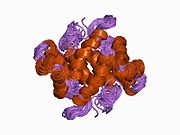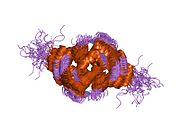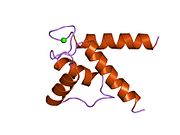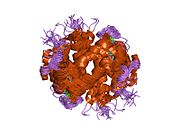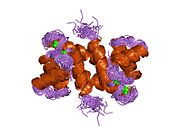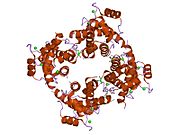S100B
Ensembl | |||||||||
|---|---|---|---|---|---|---|---|---|---|
| UniProt | |||||||||
| RefSeq (mRNA) | |||||||||
| RefSeq (protein) | |||||||||
| Location (UCSC) | Chr 21: 46.6 – 46.61 Mb | Chr 10: 76.09 – 76.1 Mb | |||||||
| PubMed search | [3] | [4] | |||||||
| View/Edit Human | View/Edit Mouse |
S100 calcium-binding protein B (S100B) is a protein of the S100 protein family.
S100 proteins are localized in the cytoplasm and nucleus of a wide range of cells, and involved in the regulation of a number of cellular processes such as cell cycle progression and differentiation. S100 genes include at least 13 members which are located as a cluster on chromosome 1q21; however, this gene is located at 21q22.3.
Function
S100B is glial-specific and is expressed primarily by astrocytes, but not all astrocytes express S100B. It has been shown that S100B is only expressed by a subtype of mature astrocytes that ensheath blood vessels and by NG2-expressing cells.[5]
This protein may function in
Clinical significance
It has been suggested that the regulation of S100B by melittin has potential for the treatment of epilepsy.[7]
Diagnostic use
S100B is secreted by astrocytes or can spill from injured cells and enter the extracellular space or bloodstream. Serum levels of S100B increase in patients during the acute phase of brain damage. Over the last decade, S100B has emerged as a candidate peripheral biomarker of
Interactions
S100B has been shown to
- AHNAK,[14]
- IMPA1,[15]
- IQGAP1,[16]
- MAPT,[17][18] and
- P53,[19]
- PGM1,[20]
- S100A6,[22][23]
- S100A11,[23]
- VAV1.[24]
References
- ^ a b c GRCh38: Ensembl release 89: ENSG00000160307 – Ensembl, May 2017
- ^ a b c GRCm38: Ensembl release 89: ENSMUSG00000033208 – Ensembl, May 2017
- ^ "Human PubMed Reference:". National Center for Biotechnology Information, U.S. National Library of Medicine.
- ^ "Mouse PubMed Reference:". National Center for Biotechnology Information, U.S. National Library of Medicine.
- PMID 18948166.
- ^ "Entrez Gene: S100B S100 calcium binding protein B".
- ^ Verma N, Karmakar M, Singh KP, Smita S (February 2013). "Structural and Dynamic Insights into S100B Protein Activity Inhibition by Melittin for the Treatment of Epilepsy". International Journal of Computer Applications. NSAAILS (975–8887): 55–60.
- PMID 17319915.
- PMID 21944878.
- PMID 18221201.
- PMID 15026262.
- S2CID 205624114.
- S2CID 4333999.
- PMID 11312263.
- PMID 19593677.
- PMID 12377780.
- PMID 11264299.
- PMID 2833519.
- PMID 15178678.
- PMID 8894274.
- S2CID 4427026.
- ^ PMID 9925766.
- ^ PMID 10913138.
- PMID 10394361.
Further reading
- Schäfer BW, Heizmann CW (1996). "The S100 family of EF-hand calcium-binding proteins: functions and pathology". Trends Biochem. Sci. 21 (4): 134–40. PMID 8701470.
- Garbuglia M, Verzini M, Sorci G, Bianchi R, Giambanco I, Agneletti AL, Donato R (2000). "The calcium-modulated proteins, S100A1 and S100B, as potential regulators of the dynamics of type III intermediate filaments". Braz. J. Med. Biol. Res. 32 (10): 1177–85. PMID 10510252.
- Rothermundt M, Peters M, Prehn JH, Arolt V (2003). "S100B in brain damage and neurodegeneration". Microsc. Res. Tech. 60 (6): 614–32. S2CID 25531839.
- Michetti F, Gazzolo D (2004). "S100B testing in pregnancy". Clin. Chim. Acta. 335 (1–2): 1–7. PMID 12927678.
- Raabe A, Kopetsch O, Woszczyk A, Lang J, Gerlach R, Zimmermann M, Seifert V (2004). "Serum S-100B protein as a molecular marker in severe traumatic brain injury". Restor. Neurol. Neurosci. 21 (3–4): 159–69. PMID 14530578.
- Sen J, Belli A (2007). "S100B in neuropathologic states: the CRP of the brain?". J. Neurosci. Res. 85 (7): 1373–80. S2CID 25932611.
- Morii K, Tanaka R, Takahashi Y, Minoshima S, Fukuyama R, Shimizu N, Kuwano R (1991). "Structure and chromosome assignment of human S100 alpha and beta subunit genes". Biochem. Biophys. Res. Commun. 175 (1): 185–91. PMID 1998503.
- Allore RJ, Friend WC, O'Hanlon D, Neilson KM, Baumal R, Dunn RJ, Marks A (1990). "Cloning and expression of the human S100 beta gene". J. Biol. Chem. 265 (26): 15537–43. PMID 2394738.
- Duncan AM, Higgins J, Dunn RJ, Allore R, Marks A (1989). "Refined sublocalization of the human gene encoding the beta subunit of the S100 protein (S100B) and confirmation of a subtle t(9;21) translocation using in situ hybridization". Cytogenet. Cell Genet. 50 (4): 234–5. PMID 2530061.
- Baudier J, Cole RD (1988). "Interactions between the microtubule-associated tau proteins and S100b regulate tau phosphorylation by the Ca2+/calmodulin-dependent protein kinase II". J. Biol. Chem. 263 (12): 5876–83. PMID 2833519.
- Allore R, O'Hanlon D, Price R, Neilson K, Willard HF, Cox DR, Marks A, Dunn RJ (1988). "Gene encoding the beta subunit of S100 protein is on chromosome 21: implications for Down syndrome". Science. 239 (4845): 1311–3. PMID 2964086.
- Jensen R, Marshak DR, Anderson C, Lukas TJ, Watterson DM (1985). "Characterization of human brain S100 protein fraction: amino acid sequence of S100 beta". J. Neurochem. 45 (3): 700–5. S2CID 46028228.
- Baudier J, Glasser N, Haglid K, Gerard D (1984). "Purification, characterization and ion binding properties of human brain S100b protein". Biochim. Biophys. Acta. 790 (2): 164–73. PMID 6487634.
- Adams MD, Kerlavage AR, Fleischmann RD, Fuldner RA, Bult CJ, Lee NH, Kirkness EF, Weinstock KG, Gocayne JD, White O (1995). "Initial assessment of human gene diversity and expression patterns based upon 83 million nucleotides of cDNA sequence" (PDF). Nature. 377 (6547 Suppl): 3–174. PMID 7566098.
- Schäfer BW, Wicki R, Engelkamp D, Mattei MG, Heizmann CW (1995). "Isolation of a YAC clone covering a cluster of nine S100 genes on human chromosome 1q21: rationale for a new nomenclature of the S100 calcium-binding protein family". Genomics. 25 (3): 638–43. PMID 7759097.
- Reeves RH, Yao J, Crowley MR, Buck S, Zhang X, Yarowsky P, Gearhart JD, Hilt DC (1994). "Astrocytosis and axonal proliferation in the hippocampus of S100b transgenic mice". Proc. Natl. Acad. Sci. U.S.A. 91 (12): 5359–63. PMID 8202493.
- Engelkamp D, Schäfer BW, Mattei MG, Erne P, Heizmann CW (1993). "Six S100 genes are clustered on human chromosome 1q21: identification of two genes coding for the two previously unreported calcium-binding proteins S100D and S100E". Proc. Natl. Acad. Sci. U.S.A. 90 (14): 6547–51. PMID 8341667.
- Peña LA, Brecher CW, Marshak DR (1997). "beta-Amyloid regulates gene expression of glial trophic substance S100 beta in C6 glioma and primary astrocyte cultures". Brain Res. Mol. Brain Res. 34 (1): 118–26. PMID 8750867.
- Argandoña EG, Bengoetxea H, Lafuente JV (2009). "Physical exercise is required for environmental enrichment to offset the quantitative effects of dark-rearing on the S-100β astrocytic density in the rat visual cortex". PMID 19500177.
- Landar A, Caddell G, Chessher J, Zimmer DB (1997). "Identification of an S100A1/S100B target protein: phosphoglucomutase". Cell Calcium. 20 (3): 279–85. PMID 8894274.
This article incorporates text from the United States National Library of Medicine, which is in the public domain.


